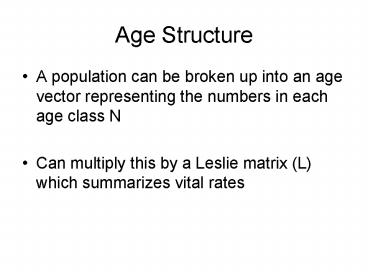Age Structure - PowerPoint PPT Presentation
1 / 20
Title:
Age Structure
Description:
Can multiply this by a Leslie matrix (L) which summarizes vital rates. Age Structure ... If we multiply any number by 1 the answer is just the number we started with. ... – PowerPoint PPT presentation
Number of Views:128
Avg rating:3.0/5.0
Title: Age Structure
1
Age Structure
- A population can be broken up into an age vector
representing the numbers in each age class N - Can multiply this by a Leslie matrix (L) which
summarizes vital rates
2
Age Structure
- Can use the Leslie matrix to calculate the
numbers in each age class at the next time step - Nt1LNt
- Nt LtN0
- To calculate the population after t years you
would have to multiply the initial population
(N0) by the Leslie matrix (L) t times
3
Age Structure
- The stable age distribution refers to the ratio
of individuals in a given age class (Not the
number of individuals) - If we assume ratio of year classes is constant,
than growth rates must affect year classes
equally. - LN?N
4
Age Structure
- LN?N
N
L
5
Eigenvalues and Eigenvectors
- If you know the Leslie matrix and Age vector you
can summarize population growth rate with
eigenvalues and eigenvectors
6
Age Structure
- Start with LN?N
- LN-?N0
- LN-?IN0 where I represents the identity
- matrix
7
Identity matrix
- If we multiply any number by 1 the answer is just
the number we started with. The number 1 is
called the multiplicative identity. The matrix
that plays the same role is called the identity
matrix and is denoted by I, so INN for any
matrix or vector N of the appropriate size. The
identity matrix with two rows and columns is
I
8
Age Structure
- Start with LN?N
- LN-?N0
- LN-?IN0
- (L-?I)N0
9
Age Structure
- A fact from matrix algebra is the final equation
is solved if and only if the determinant of
(L-?I)0
10
Determinant of a matrix
- If A
Then det(A) AD - BC
11
Age Structure
- So say L
?I
L-?I
12
Age Structure
det(L-?I)0
det(L-?I)(a11- ?)(a22- ?)-a12a22
Can solve for ? with the quadratic formula
13
Quadratic formula
ax2bxc0
14
Eigenvector
- Now that we have the eigenvalues, we can find the
corresponding eigenvectors - NtLtN0
- Let ?0 and ?1 be the two eigenvalues and v0 and
v1 be the corresponding eigenvectors
15
Eigenvectors
- We will first express initial population size
(N0) as the sum of the two eigenvectors - N0a0v0 a1v1
- NtLtN0Lt(a0v0a1v1)
- a0
v0
a1
v1
If ?0 gt ?1 then Nt?a0 ?0tv0
16
Solving for eigenvector
- L
- Find the eigenvector v0 that corresponds to the
dominant eigenvalue ?0 such that Lv0 ?0v0. Try
vector of the form
17
Solving for eigenvector
- Thus,
- a11a12?0
- a21 a22b ?0b
- In general each equation will have the same
solution for b. The resulting vector represents
the stable age distribution.
18
Eigenvector
- Typically the age distribution vector is
expressed so that the abundance of each age class
is given as a proportion of the total population
(i.e. nx sum to 1)
19
EXAMPLES
- By Hand
- Excel
- R
- Matlab example from TJ Case
20
Summary
- Age specific vital rates can be expressed in a
square matrix called a Leslie Matrix (L). - Can use this matrix and an initial age vector N0
to calculate the total population size at time t - Eventually population will approach a stable age
structure and an ultimate geometric growth rate - Can determine ultimate geometric growth rate by
finding the dominant eigenvalue of L. - The corresponding eigenvector represents the
stable age distribution






























